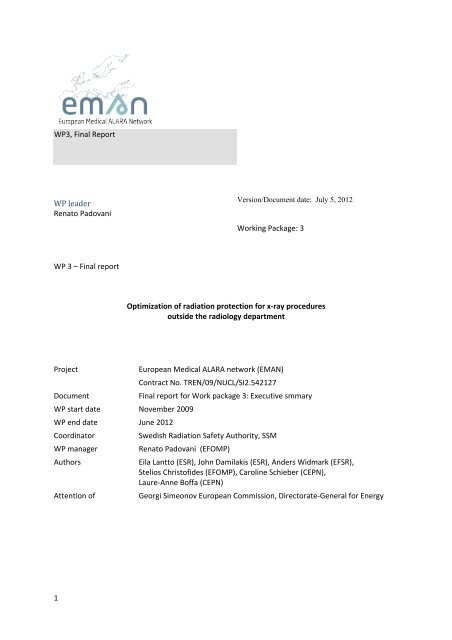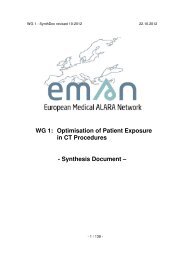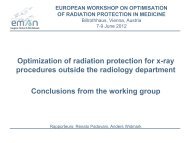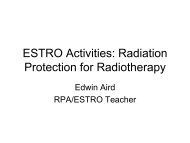WG3 Final Report - European Medical ALARA Network (EMAN)
WG3 Final Report - European Medical ALARA Network (EMAN)
WG3 Final Report - European Medical ALARA Network (EMAN)
You also want an ePaper? Increase the reach of your titles
YUMPU automatically turns print PDFs into web optimized ePapers that Google loves.
WP3, <strong>Final</strong> <strong>Report</strong> <br />
WP leader <br />
Renato Padovani <br />
Version/Document date: July 5, 2012<br />
Working Package: 3 <br />
WP 3 – <strong>Final</strong> report <br />
Optimization of radiation protection for x-‐ray procedures <br />
outside the radiology department <br />
Project <br />
Document <br />
WP start date <br />
WP end date <br />
Coordinator <br />
WP manager <br />
Authors <br />
Attention of <br />
<strong>European</strong> <strong>Medical</strong> <strong>ALARA</strong> network (<strong>EMAN</strong>) <br />
Contract No. TREN/09/NUCL/SI2.542127 <br />
<strong>Final</strong> report for Work package 3: Executive smmary <br />
November 2009 <br />
June 2012 <br />
Swedish Radiation Safety Authority, SSM <br />
Renato Padovani (EFOMP) <br />
Eila Lantto (ESR), John Damilakis (ESR), Anders Widmark (EFSR), <br />
Stelios Christofides (EFOMP), Caroline Schieber (CEPN), <br />
Laure-‐Anne Boffa (CEPN) <br />
Georgi Simeonov <strong>European</strong> Commission, Directorate-‐General for Energy <br />
1
Content <br />
Executive summary .............................................................................................................................3 <br />
Recommendation to the EC ................................................................................................................5 <br />
Conclusions from the workshop .........................................................................................................6 <br />
Administrative summary.....................................................................................................................6 <br />
<strong>Network</strong>ing challenges........................................................................................................................7 <br />
Attachments........................................................................................................................................7 <br />
2
Executive summary <br />
Radiation protection of patients and staff for practices performed outside radiological departments <br />
are of particular interest due to: <br />
3 <br />
−<br />
−<br />
−<br />
−<br />
the limited information on type and frequency of procedures performed mainly with mobile <br />
radiography and fluoroscopy equipment, <br />
the increased frequency of procedures, some of them complex, in surgical theatres, <br />
the limited information on patient and staff exposure involved, <br />
the fact that procedures are performed by non-‐radiologists and nurses with poor or without <br />
training on radiation protection and procedure optimisation. <br />
The practices where patient and staff exposures require optimisation have been identified in the <br />
following clinical areas: vascular surgery, gastroenterology, urology, orthopaedics, neurosurgery, <br />
anaesthesiology, gynaecology and X-‐rays at bedside. <br />
The <strong>EMAN</strong> WG 3 is composed by radiologists, medical physicists, radiographers and radiation <br />
protection experts representing major <strong>European</strong> professional and scientific groups in this field, the <br />
<strong>European</strong> Society of Radiology (ESR), the <strong>European</strong> Federation of Organisations for <strong>Medical</strong> Physics <br />
(EFOMP), the <strong>European</strong> Federation of Radiographer Societies (EFSR) and the CEPN, a French radiation <br />
protection body. A representative of the <strong>European</strong> Society of Gastrointestinal Endoscopy (ESGE) has <br />
joined the group from the 3 rd meeting to develop a networking experience with a stakeholder <br />
performing an important fraction of radiological practices outside radiology department. <br />
The WG 3 had 5 face-‐to-‐face meetings and several distant contacts. In the first phase of the project <br />
the WG collected and analysed the existing information on the practices, trying to identify lack of <br />
information and optimisation and developing a synthesis document where elements of <br />
recommendations have been included. <br />
Synthesis document <br />
The Chapter 1 provides an overview on the impact on population exposure of radiology, nuclear <br />
medicine and dental practices, as derived by the DoseDatamed survey in 2004-‐2007. It is reported <br />
that for practices performed outside radiological departments there are limited information on <br />
frequency and patient and staff doses. <br />
In chapters 2 and 3 a description of the most frequent radiological procedures and literature, data on <br />
frequencies on patient and staff doses are reported. The evidence is that only for few procedures, <br />
literature patient data are relative numerous and demonstrating the existence of large variation of <br />
patient doses. Staff dose data are always limited and reported with different quantities, making <br />
comparison difficult. Because literature is not reporting frequencies, some preliminary evaluations <br />
have been derived from data collected in WG member’s hospitals. <br />
When a limited set of patient dose data is available, a pragmatic methodology to assess Diagnostic <br />
Reference Levels (DRL), has been proposed as the 3 rd quartile of the distribution of the mean values <br />
from a sample of installation for fluoroscopy time and KAP. <br />
Chapter 4 describes the mobile radiography and fluoroscopy equipment technology and the relevant <br />
international standards, like CE mark of medical devices, IEC and CENELEC. The quality assurance <br />
programme, required by the MED EU Directive, includes the quality control programme of the <br />
radiological equipment. In documents of AAPM (US) and IPEM (UK), the Quality control of x-‐ray units <br />
is adequately covered. <br />
Staff protection devices and discussion on the effectiveness of the shielding are included in chapter <br />
5. Because there is a non harmonised adoption of protective devices, the development of a guideline <br />
specific for the different specialties is necessary. Chapter 6 on staff exposure monitoring discusses <br />
the methods for the evaluation of personal dosimetry data, including the investigation of high dose
levels. The survey conducted in 7 <strong>European</strong> countries on personal monitoring practice is reported as <br />
an example of the differences in the national monitoring practices. A review of the EC RP <strong>Report</strong> 160 <br />
on technical recommendation of staff monitoring is provided as guidance. <br />
Chapter 7 introduces direct, indirect and calculation methods for patient dosimetry. As an example of <br />
the differences in the patient dosimetry practice, a detailed description of the approached adopted <br />
in 5 <strong>European</strong> countries is reported. <br />
Education and training in radiation protection of the personnel is discussed in chapter 8 starting from <br />
the results of a survey conducted in 23 <strong>European</strong> countries demonstrating a non harmonised <br />
approach to education and training. In particular the need of a more effective harmonisation and <br />
implementation of the national regulations, the introduction of a credentialing system for RP, the <br />
reinforcement of the importance of the Continuous Professional Development system are <br />
underlined. <br />
Chapter 9 on clinical audit, reports the fact that only Finland has performed a clinical audit on the <br />
radiological practices outside radiology. In this survey the auditors gave a number of <br />
recommendations about fluoroscopy outside radiological departments, mainly about training and <br />
education of the staff, the use of shielding devices, and examination guidelines. Chapter 10 reports <br />
the main outcomes from the inspection on these practices in Norway. Interviews revealed serious <br />
lack of skills in radiation protection, for example: staff were unable to identify the X-‐ray tube from <br />
the image intensifier of the C-‐arm, had inadequate knowledge of the operating console, of the three <br />
cardinal principles for staff protection (time, distance and shielding) and, total lack of knowledge <br />
about patient doses and risks. <strong>Final</strong>ly, chapter 11 collects a list of lessons learned and examples of <br />
bad practices, material that can be conveniently used in training courses. <br />
Recommendations <br />
The synthesis document is providing an overview of the present status of the optimisation level of <br />
the radiological practices performed outside the radiology department and provides the basis for the <br />
development of a <strong>European</strong> guideline. <br />
The identified lack of optimisation allows identifying actions useful to improve optimisation levels, <br />
summarised in the following recommendations: <br />
1. The lack of information on the practice requires <strong>European</strong> scientific societies to promote national <br />
data collections. EC should also strengthen Member States to implement the practice of patient <br />
dose monitoring, as requested by MED for these “special practices”. <br />
2. A methodology to assess DRLs, when a limited set of data is available, is proposed. The 3 rd<br />
quartile of the distribution of the mean values for fluoroscopy time and KAP from a sample of <br />
installation can pragmatically provide preliminary reference levels. EC and <strong>European</strong> scientific <br />
societies have to develop <strong>European</strong> surveys aiming to assess and adopt DRLs. <br />
3. Staff exposure monitoring requires harmonisation because countries have different <br />
recommendations or some don’t have at all. <strong>EMAN</strong> should support HERCA to develop a <strong>European</strong> <br />
recommendation. The recommendation should promote also the use of additional active <br />
dosimeters for educational purposes, the identification of high dose procedures requiring hand <br />
and eye lens dosimetry and the adoption of ambient dosimetry, as part of the radiological <br />
equipment. <br />
4. HERCA should also work on the harmonisation of national staff dosimetry databases where the <br />
inclusion of specialist radiological workload will allow extracting dose information for specific <br />
group of specialists. <br />
5. Inadequate mobile fluoroscopy equipments are frequently used to perform complex and long <br />
procedures in surgical theatres. International standards should require equipment functions to <br />
reduce patient and staff doses, including provisions for staff shielding. COCIR should promote <br />
this action. Hospitals are invited to provide adequate shielding to high workload mobile <br />
fluoroscopy units and to acquire new equipments with KAP display, as required by MED. <br />
4
6. Hospitals should be encouraged to setup patient dose information systems to automatically <br />
collect patient doses for a better monitoring of the practices adopting existing international <br />
standards, e.g. IHE REM profile (Radiation Exposure Monitoring Integration Profile, Integrating <br />
the Healthcare Enterprise). COCIR should promote the development of such information <br />
systems. <br />
7. Education and training of professionals involved are seen as a priority. Most of practitioners have <br />
little or no education in radiation protection and optimisation methods. Specific methodologies <br />
are required to reach the large number of practitioners (medical specialists, nurses, <br />
radiographers and medical physicists). MEDRAPET recommendations will properly address on the <br />
training methodology and contents (KSC methodology), while knowledge can be conveniently <br />
provided via the development of distance learning tools, while hospitals should provide the skill <br />
via practical exercises. <strong>EMAN</strong> should promote these actions and offer educational sessions at the <br />
<strong>European</strong> congresses of the different specialities. <br />
8. Clinical audit, as requested by MED, has been performed only in one <strong>European</strong> country. Starting <br />
from this experience <strong>EMAN</strong> can develop proper methodology and setup multidisciplinary teams. <br />
9. Inspection activity is again rarely performed. <strong>EMAN</strong> can recommend to HERCA the development <br />
of guidelines and support inspectors training. <br />
10. Stakeholder’s involvement. The experience and the agreement reached with the <strong>European</strong> <br />
Society of Gastrointestinal Endoscopy (ESGE) can be taken by <strong>EMAN</strong> as a model to propose to <br />
other professional specialities to enlarge the network <br />
11. Optimisation of the practices. It is recommended to hospitals to setup a multidisciplinary “core <br />
team” to support optimisation. <strong>EMAN</strong> has also developed a list of contents for a guideline for <br />
optimisation. The guideline content is addressed to EC that should consider the opportunity to <br />
develop a Radiation protection Guideline for the optimisation of radiological practices performed <br />
outside radiology departments. <br />
Recommendation to the EC <br />
The following recommendations are addressed to the <strong>European</strong> Commission as an outcome of the <br />
WG to improve optimisation in the radiological practice performed outside radiology departments: <br />
1. EC should also strengthen the patient dose monitoring at the hospital level as requested by MED <br />
for these “special practices”. <br />
2. <strong>EMAN</strong> has proposed a methodology to assess DRLs when a limited set of data is available. In the <br />
context of the necessary revision of the EC Guidance on Diagnostic Reference Levels for <strong>Medical</strong> <br />
Exposure (RP 109) it is recommended to assess and include specific DRLs for the most frequent <br />
procedures performed outside radiology departments. <br />
3. EC should recommend to Member States to apply harmonised staff exposure monitoring <br />
guidelines. The guideline should be conveniently developed by HERCA and <strong>EMAN</strong>. <br />
4. EC should recommend to Member States to apply art. 8.6 of the MED Directive where new <br />
radiological equipment shall have a device informing the practitioner of the quantity of radiation <br />
produced by the equipment during the radiological procedure. <br />
5. EC should promote clinical audit and inspection activities. <strong>EMAN</strong> can support such actions <br />
developing specific methodology to apply in pilot project via multidisciplinary teams. <br />
6. Because of the lack of optimisation in these practices, EC should consider the opportunity to <br />
develop a Radiation protection Guideline for the optimisation of radiological practices performed <br />
outside radiology departments. A draft structure is proposed by <strong>EMAN</strong>. <br />
5
Conclusions from the workshop <br />
WP3 prepared the workgroup activity at the workshop discussing optimisation issues in the identified <br />
«special practice», reported in order of relevance: vascular surgery, gastroenterology, urology, <br />
orthopaedics, neurosurgery, anaesthesiology, general surgery, gynaecology, neonatology (bedside X-rays),<br />
dentistry (above all cone beam CT). <br />
In the three workgroup sessions, the problems, action plan and future <strong>EMAN</strong> activities have been <br />
discussed and the following recommendations agreed as priorities for the improvement of <br />
optimisation. Recommendations are addressed to <strong>EMAN</strong>, for its future activity as a sustainable <br />
network, to EC, HERCA and <strong>European</strong> scientific societies representing medical specialists, <br />
radiographers and nurses involved in the radiological practices performed outside radiology <br />
departments. <br />
1. Data collection on frequency of procedures and related patient and staff doses. Dose <br />
monitoring for special practices, as required by the Directive, is not common and should be <br />
realised through the <strong>European</strong> scientific societies and at the national level. <br />
2. There is the need to asses DRLs for frequent and for high-‐dose procedures. <br />
3. The EC has to develop a specific RP Guideline for the optimisation of special practices and <br />
<strong>EMAN</strong> should contribute. <br />
4. Harmonisation of staff monitoring is necessary. A <strong>European</strong> recommendation, developed <br />
together by HERCA and <strong>EMAN</strong> should be promoted. <br />
5. Mobile fluoroscopy equipment for complex and long procedures used in surgical theatres are <br />
frequently inadequate. COCIR should promote the development of revised standards for <br />
equipment and shielding, and patient dose monitoring devices. <br />
6. Most practitioners have little or no education and training in RP. MEDRAPET <br />
recommendations should address learning objectives (KSC) and <strong>EMAN</strong> should promote and <br />
develop distance learning tools and courses. Hospitals should be encouraged to provide <br />
practical training. Hospitals can benefit in setting up a multidisciplinary core team. <br />
7. Clinical audit. The methodology for special practices should be developed and <strong>EMAN</strong> can <br />
contribute. <br />
8. HERCA should promote inspections and <strong>EMAN</strong> can contribute to guideline development. <br />
9. Stakeholders involvement in <strong>EMAN</strong> is probably the most critical and difficult task. The <br />
experience with ESGE should be used as a model for future networking. <br />
Administrative summary <br />
The <strong>EMAN</strong> WG 3 is composed by radiologists, medical physicists, radiographers and radiation <br />
protection experts representing major <strong>European</strong> professional and scientific groups in this field, the <br />
<strong>European</strong> Society of Radiology (ESR), the <strong>European</strong> Federation of Organisations for <strong>Medical</strong> Physics <br />
(EFOMP), the <strong>European</strong> Federation of Radiographer Societies (EFSR) and the CEPN, a French radiation <br />
protection body. <br />
Members of the WG 3: <br />
NAME e-‐mail address Appointed by <br />
Anders Widmark anders.widmark@nrpa.no ESFR <br />
Caroline Schieber schieber@cepn.asso.fr CEPN <br />
Celine Bataille bataille@cepn.asso.fr CEPN (until September 2010) <br />
Laure-‐Anna Boffa laure-‐anne.boffa@cepn.asso.fr CEPN (since October 2010) <br />
Eila Lantto eila.lantto@phsotey.fi ESR <br />
John Damilakis damilaki@med.uoc.gr ESR <br />
Stelios Christofides cstelios@cytanet.com.cy EFOMP <br />
Renato Padovani padovani.renato@aoud.sanita.fvg.it EFOMP <br />
6
Representatives of the <strong>European</strong> Society of Gastrointestinal Endoscopy (ESGE) has joined the group <br />
from the 3 rd meeting. <br />
The WG had 5 face-‐to-‐face meetings (5 minutes attached) and several distant contacts. <br />
The WG has conducted on these radiological practices surveys on: <br />
status and recommendations for staff dose monitoring in fluoroscopy guided procedures (7 <br />
countries); <br />
education and training regulation and practice in 23 <strong>European</strong> countries; <br />
clinical audit experiences; <br />
inspection activities; <br />
frequency, patient and staff doses in some hospitals of Cyprus, Finland, Italy, Norway to <br />
integrate literature data; <br />
<strong>Network</strong>ing challenges <br />
The more than 2 years activity of this working group has demonstrated the possibility and the benefit <br />
to work in a multidisciplinary team in different ways, i.e. face-‐to-‐face meetings, document <br />
developments, Workshop group work, e-‐meetings, etc. <br />
The WG 3 mandate was also to attract other stakeholders. Here the activity developed with the ESGE <br />
(<strong>European</strong> Society of Gastrointestinal Endoscopy) and the formal agreement reached is outlined: <br />
-‐<br />
-‐<br />
-‐<br />
-‐<br />
-‐<br />
-‐<br />
-‐<br />
to establish a common working group <br />
to develop RP Guidelines <br />
to evaluate frequency and patient doses of Gastroenterology procedures in Europe <br />
to assess DRLs (Dose Reference Levels) for ERCP <br />
to collaborate in future survey development and data analysis <br />
to develop training material on RP for education actions of ESGE and to integrate RP sessions in <br />
ESGE Workshops <br />
to contribute to the <strong>EMAN</strong> Workshop and to have links in the respective websites. <br />
This extensive and promising agreement should be taken as a model for the future enlargement of <br />
the <strong>EMAN</strong> network. <br />
<strong>EMAN</strong> has also worked with MEDRAPET providing suggestions for the education and training of the <br />
professionals involved in these practices. <br />
Attachments <br />
• Synthesis document <br />
• Structure of the proposed <strong>European</strong> Guideline on Optimisation of Radiation Protection in <br />
Radiological Practices Performed Outside the Radiological Department <br />
• Minutes of the 5 working group meetings <br />
7






